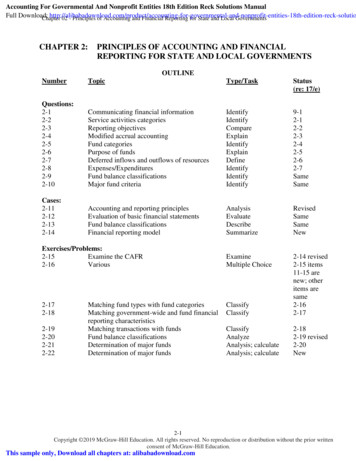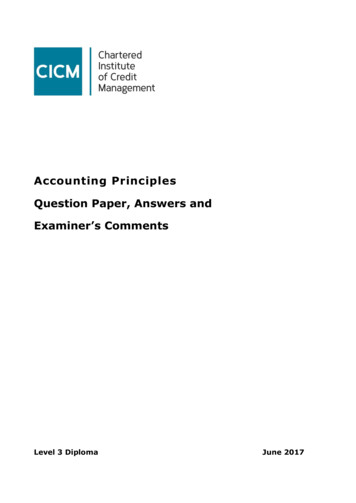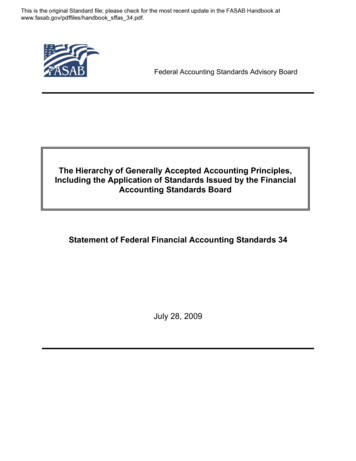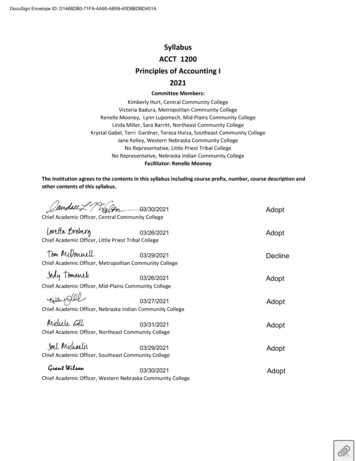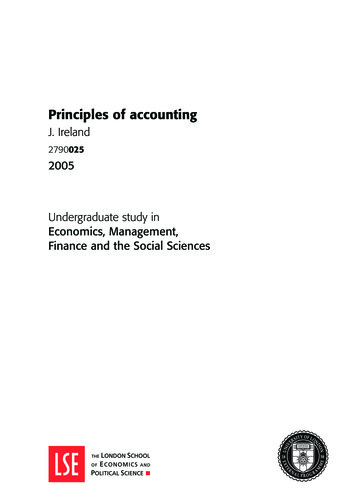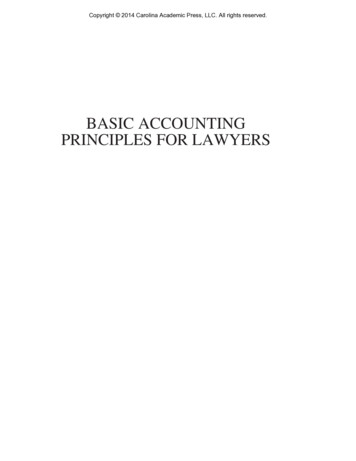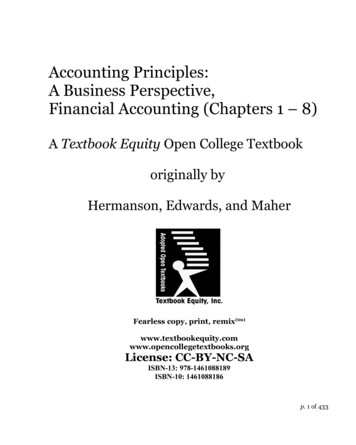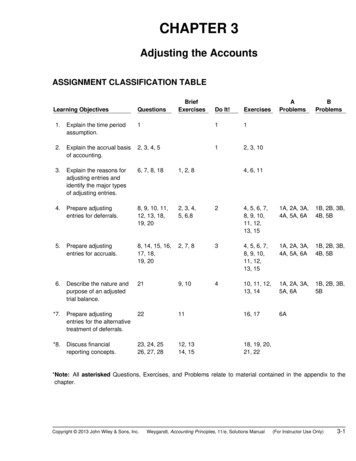
Transcription
CHAPTER 3Adjusting the AccountsASSIGNMENT CLASSIFICATION TABLELearning ObjectivesQuestions*1.Explain the time ms4, 5, 6, 7,8, 9, 10,11, 12,13, 151A, 2A, 3A,4A, 5A, 6A1B, 2B, 3B,4B, 5B34, 5, 6, 7,8, 9, 10,11, 12,13, 151A, 2A, 3A,4A, 5A, 6A1B, 2B, 3B,4B, 5B410, 11, 12,13, 141A, 2A, 3A,5A, 6A1B, 2B, 3B,5B1116, 176A12, 1314, 1518, 19, 20,21, 22Do It!Exercises111Explain the accrual basisof accounting.2, 3, 4, 512, 3, 10*3.Explain the reasons foradjusting entries andidentify the major typesof adjusting entries.6, 7, 8, 181, 2, 8*4.Prepare adjustingentries for deferrals.8, 9, 10, 11,12, 13, 18,19, 202, 3, 4,5, 6,82*5.Prepare adjustingentries for accruals.8, 14, 15, 16,17, 18,19, 202, 7, 8*6.Describe the nature andpurpose of an adjustedtrial balance.219, 10*7.Prepare adjustingentries for the alternativetreatment of deferrals.22*8.Discuss financialreporting concepts.23, 24, 2526, 27, 284, 6, 11*Note: All asterisked Questions, Exercises, and Problems relate to material contained in the appendix to thechapter.Copyright 2013 John Wiley & Sons, Inc.Weygandt, Accounting Principles, 11/e, Solutions Manual(For Instructor Use Only)3-1
ASSIGNMENT CHARACTERISTICS TABLEProblemNumberDifficultyLevelTimeAllotted (min.)1APrepare adjusting entries, post to ledger accounts,and prepare an adjusted trial balance.Simple40–502APrepare adjusting entries, post, and prepare adjustedtrial balance, and financial statements.Simple50–603APrepare adjusting entries and financial statements.Moderate40–504APrepare adjusting entries.Moderate30–405AJournalize transactions and follow through accountingcycle to preparation of financial statements.Moderate60–70Prepare adjusting entries, adjusted trial balance,and financial statements using e adjusting entries, post to ledger accounts,and prepare an adjusted trial balance.Simple40–502BPrepare adjusting entries, post, and prepare adjustedtrial balance, and financial statements.Simple50–603BPrepare adjusting entries and financial statements.Moderate40–504BPrepare adjusting entries.Moderate30–405BJournalize transactions and follow through accountingcycle to preparation of financial statements.Moderate60–70Copyright 2013 John Wiley & Sons, Inc.Weygandt, Accounting Principles, 11/e, Solutions Manual(For Instructor Use Only)
WEYGANDT ACCOUNTING PRINCIPLES 11ECHAPTER 3ADJUSTING THE ACCOUNTSNumberLOBTDifficultyTime (min.)BE13CSimple4–6BE23, 4, 6BE83, 4, e2–4BE14*8CSimple2–4BE15*8CSimple1–2DI11, ��15EX32APSimple6–8EX43, 4, 5ANSimple5–6EX54, 5ANModerate10–15EX63–5ANModerate10–12EX74, 5ANModerate8–10EX84, 5ANModerate8–10EX94, 5ANSimple8–10EX102, APSimple12–15Copyright 2013 John Wiley & Sons, Inc.Weygandt, Accounting Principles, 11/e, Solutions Manual(For Instructor Use Only)3-3
ADJUSTING THE ACCOUNTS (Continued)NumberLOBTDifficultyTime (min.)EX154, 5AN, 0P3A4–6ANModerate40–50P4A4, NSimple50–60P3B4–6ANModerate40–50P4B4, 5ANModerate30–40P5B4–6ANModerate60–70BYP14, 5, 4Copyright 2013 John Wiley & Sons, Inc.Weygandt, Accounting Principles, 11/e, Solutions Manual(For Instructor Use Only)
Learning Weygandt, Accounting Principles, 11/e, Solutions Manual(For Instructor Use Only)*1.Explain the time period assumption.DI3-1Q3-1E3-1*2.Explain the accrual basis of accounting.DI3-1Q3-2Q3-3Q3-4 Q3-5E3-3E3-10*3.Explain the reasons for adjusting entries andidentify the major types of adjusting entries.Q3-6Q3-7Q3-8BE3-1Q3-18 BE3-8 E3-6BE3-2 E3-4E3-11*4.Prepare adjusting entries for .Prepare adjusting entries for accruals.Q3-8Q3-14Q3-15Q3-19Q3-20*6.Describe the nature and purpose of anadjusted trial balance.Q3-21*7.Prepare adjusting entries for the alternativetreatment of deferrals.*8.Discuss financial reporting conceptsBroadening Your l ReportingComparative AnalysisReal-World FocusDecision Making All About YouEthics CaseAcross theConsideringOrganizationP, P & PBLOOM’S TAXONOMY TABLECopyright 2013 John Wiley & Sons, Inc.Correlation Chart between Bloom’s Taxonomy, Learning Objectives and End-of-Chapter Exercises and Problems
ANSWERS TO QUESTIONS1.(a) Under the time period assumption, an accountant is required to determine the relevance ofeach business transaction to specific accounting periods.(b) An accounting time period of one year in length is referred to as a fiscal year. A fiscal yearthat extends from January 1 to December 31 is referred to as a calendar year. Accountingperiods of less than one year are called interim periods.2.The two generally accepted accounting principles that relate to adjusting the accounts are:The revenue recognition principle, which states that revenue should be recognized in the accountingperiod in which services are performed.The expense recognition principle, which states that efforts (expenses) be matched withaccomplishments (revenues).3.The law firm should recognize the revenue in April. The revenue recognition principle states thatrevenue should be recognized in the accounting period in which services are performed.4.Information presented on an accrual basis is more useful than on a cash basis because it revealsrelationships that are likely to be important in predicting future results. To illustrate, under accrualaccounting, revenues are recognized when the performance obligation is satisfied so they can berelated to the economic environment in which they occur. Trends in revenues are thus moremeaningful.5.Expenses of 4,500 should be deducted from the revenues in April. Under the expenserecognition principle efforts (expenses) should be matched with accomplishments (revenues).6.No, adjusting entries are required by the revenue recognition and expense recognition principles.7.A trial balance may not contain up-to-date information for financial statements because:(1) Some events are not journalized daily because it is not efficient to do so.(2) The expiration of some costs occurs with the passage of time rather than as a result of dailytransactions.(3) Some items may be unrecorded because the transaction data are not yet known.8.The two categories of adjusting entries are deferrals and accruals. Deferrals consist of prepaidexpenses and unearned revenues. Accruals consist of accrued revenues and accrued expenses.9.In the adjusting entry for a prepaid expense, an expense is debited and an asset is credited.10.No. Depreciation is the process of allocating the cost of an asset to expense over its useful life ina rational and systematic manner. Depreciation results in the presentation of the book value ofthe asset, not its fair value.11.Depreciation expense is an expense account whose normal balance is a debit. This accountshows the cost that has expired during the current accounting period. Accumulated depreciationis a contra asset account whose normal balance is a credit. The balance in this account is thedepreciation that has been recognized from the date of acquisition to the balance sheet date.12.Equipment .Less: Accumulated Depreciation—Equipment.3-6Copyright 2013 John Wiley & Sons, Inc.Weygandt, Accounting Principles, 11/e, Solutions Manual 18,0006,000 12,000(For Instructor Use Only)
Questions Chapter 3 (Continued)*13.In the adjusting entry for an unearned revenue, a liability is debited and a revenue is credited.*14.Asset and revenue. An asset would be debited and a revenue would be credited.*15.An expense is debited and a liability is credited in the adjusting entry.*16.Net income was understated 200 because prior to adjustment, revenues are understated by 900 and expenses are understated by 700. The difference in this case is 200 ( 900 – 700).*17.The entry is:Jan. 9Salaries and Wages Payable .Salaries and Wages Expense .Cash .2,0003,0005,000*18.(a) Accrued revenues.(b) Unearned revenues.(c) Accrued expenses.(d) Accrued expenses or prepaid expenses.(e) Prepaid expenses.(f) Accrued revenues or unearned revenues.*19.(a) Salaries and Wages Payable.(b) Accumulated Depreciation.(c) Interest Expense.(d) Supplies Expense.(e) Service Revenue.(f) Service Revenue.*20.Disagree. An adjusting entry affects only one balance sheet account and one income statementaccount.*21.Financial statements can be prepared from an adjusted trial balance because the balances ofall accounts have been adjusted to show the effects of all financial events that have occurredduring the accounting period.*22.For Supplies Expense (prepaid expense): expenses are overstated and assets are understated.The adjusting entry is:Assets (Supplies) .XXExpenses (Supplies Expense) .XXFor Rent Revenue (unearned revenues): revenues are overstated and liabilities are understated.The adjusting entry is:Revenues (Rent Revenue) .XXLiabilities (Unearned Rent Revenue) .XX**23. (a) The primary objective of financial reporting is to provide financial information that is useful toinvestors and creditors for making decisions about providing capital.(b) The fundamental qualitative characteristics are relevance and faithful representation. Theenhancing qualities are comparabiIity, consistency, verifiability, timeliness, andunderstandability.*24.Gross is correct. Consistency means using the same accounting principles and accountingmethods from period to period within a company. Without consistency in the application ofaccounting principles, it is difficult to determine whether a company is better off, worse off, orthe same from period to period.Copyright 2013 John Wiley & Sons, Inc.Weygandt, Accounting Principles, 11/e, Solutions Manual(For Instructor Use Only)3-7
Questions Chapter 3 (Continued)*25.Comparability results when different companies use the same accounting principles.Consistency means using the same accounting principles and methods from year to year withinthe same company.*26.The constraint is the cost constraint. The cost constraint allows accounting standard setters toweigh the cost that companies will incur to provide information against the benefit that financialstatement users will gain from having the information available.*27.Accounting relies primarily on two measurement principles. Fair value is sometimes used whenmarket price information is readily available. However, in many situations reliable market priceinformation is not available. In these instances, accounting relies on cost as its basis.*28.The economic entity assumption states that every economic entity can be separately identifiedand accounted for. This assumption requires that the activities of the entity be kept separate anddistinct from (1) the activities of its owners (the shareholders) and (2) all other economic entities.A shareholder of a company charging personal living costs as expenses of the company is anexample of a violation of the economic entity assumption.3-8Copyright 2013 John Wiley & Sons, Inc.Weygandt, Accounting Principles, 11/e, Solutions Manual(For Instructor Use Only)
SOLUTIONS TO BRIEF EXERCISESBRIEF EXERCISE 3-1(a) Prepaid Insurance—to recognize insurance expired during the period.(b) Depreciation Expense—to account for the depreciation that has occurredon the asset during the period.(c) Unearned Service Revenue—to record revenue earned for servicesperformed.(d) Interest Payable—to recognize interest accrued but unpaid on notespayable.BRIEF EXERCISE 3-2(a)Type of Adjustment(b)Account Balances before Adjustment1.Prepaid ExpensesAssets OverstatedExpenses Understated2.Accrued RevenuesAssets UnderstatedRevenues Understated3.Accrued ExpensesExpenses UnderstatedLiabilities Understated4.Unearned RevenuesLiabilities OverstatedRevenues UnderstatedItemBRIEF EXERCISE 3-3Dec. 31Supplies Expense .Supplies ( 6,700 – 2,500) .Supplies6,700 12/3112/31 Bal. 2,500Copyright 2013 John Wiley & Sons, Inc.4,20012/314,2004,200Supplies Expense4,200Weygandt, Accounting Principles, 11/e, Solutions Manual(For Instructor Use Only)3-9
BRIEF E
Copyright 2013 John Wiley & Sons, Inc. Weygandt, Accounting Principles, 11/e, Solutions Manual (For Instructor Use Only) 3-7 Questions Chapter 3 (Continued) *13 .
